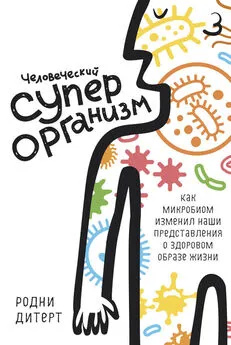Роб Найт - Смотри, что у тебя внутри. Как микробы, живущие в нашем теле, определяют наше здоровье и нашу личность
- Название:Смотри, что у тебя внутри. Как микробы, живущие в нашем теле, определяют наше здоровье и нашу личность
- Автор:
- Жанр:
- Издательство:АСТ: CORPUS
- Год:2015
- Город:Москва
- ISBN:978-5-17-091312-1
- Рейтинг:
- Избранное:Добавить в избранное
-
Отзывы:
-
Ваша оценка:
Роб Найт - Смотри, что у тебя внутри. Как микробы, живущие в нашем теле, определяют наше здоровье и нашу личность краткое содержание
Смотри, что у тебя внутри. Как микробы, живущие в нашем теле, определяют наше здоровье и нашу личность - читать онлайн бесплатно полную версию (весь текст целиком)
Интервал:
Закладка:
70
M. Noval Rivas et al., “A Microbiota Signature Associated With Experimental Food Allergy Promotes Allergic Sensitization and Anaphylaxis,” Journal of Allergy and Clinical Immunology 131, no. 1 (Jan. 2013): 201–12.
71
M. S. Kramer et al., “Promotion of Breastfeeding Intervention Trial (PROBIT): a ClusterRandomized Trial in the Republic of Belarus. Design, Follow-Up, and Data Validation,” Advances in Experimental Medicine and Biology 478 (2000): 327–45.
72
H. Kronborg et al., “Effect of Early Postnatal Breastfeeding Support: a Cluster-Randomized Community Based Trial,” Acta Pediatrica 96, no. 7 (July 2007): 1064–70.
73
I. Hanski et al., “Environmental Biodiversity, Human Microbiota, and Allergy Are Interrelated,” Proceedings of the National Academy of Sciences 109, no. 21 (May 22, 2012): 8334–9.
74
C. G. Carson, “Risk Factors for Developing Atopic Dermatitis,” Danish Medical Journal 60, no. 7 (July 2013): B4687.
75
E. von Mutius et al., “The PASTURE Project: E. U. Support for the Improvement of Knowledge About Risk Factors and Preventive Factors for Atopy in Europe,” Allergy 61, no. 4 (April 2006): 407–13.
76
S. J. Song et al., “Cohabiting Family Members Share Microbiota With One Another and With Their Dogs,” eLife 2 (April 16, 2013).
77
B. Brunekreef et al., “Exposure to Cats and Dogs, and Symptoms of Asthma, Rhinoconjunctivitis, and Eczema,” Epidemiology 23, no. 5 (Sept. 2012): 742–50.
78
I. Trehan et al., “Antibiotics as Part of the Management of Severe Acute Malnutrition,” New England Journal of Medicine 368, no. 5 (January 31, 2013): 425–35.
79
M. I. Smith et al., “Gut Microbiomes of Malawian Twin Pairs Discordant for Kwashiorkor,” Science 339, no. 6119 (February 1, 2013): 548–54.
80
Turnbaugh et al., “Core Gut Microbiome in Obese and Lean Twins.”
81
D. N. Frank et al., “MolecularPhylogenetic Characterization of Microbial Community Imbalances in Human Inflammatory Bowel Diseases,” Proceedings of the National Academy of Sciences of the United States of America 104, no. 34 (August 21, 2007): 13780–85; M. Tong et al., “A Modular Organization of the Human Intestinal Mucosal Microbiota and Its Association with Inflammatory Bowel Disease,” PloS One 8, no. 11 (November 19, 2013): e80702.
82
J. U. Scher et al., “Expansion of Intestinal Prevotella Copri Correlates with Enhanced Susceptibility to Arthritis,” eLife 2 (November 5, 2013): e01202.
83
P. Bercik, “The MicrobiotaGut-Brain Axis: Learning from Intestinal Bacteria?”, Gut 60, no. 3 (March 2011): 288–89.
84
J. F. Cryan and S. M. O’Mahony, “The Microbiome-Gut-Brain Axis: From Bowel to Behavior,” Neurogastroenterology and Motility: The Official Journal of the European Gastrointestinal Motility Society 23, no. 3 (March 2011): 187–92.
85
A. Naseribafrouei et al., “Correlation Between the Human Fecal Microbiota and Depression,” Neurogastroenterology and Motility: The Official Journal of the European Gastrointestinal Motility Society 26, no. 8 (August 2014): 1155–62.
86
G. A. Rook, C. L. Raison, and C. A. Lowry, “Microbiota, Immunoregulatory Old Friends and Psychiatric Disorders,” Advances in Experimental Medicine and Biology 817 (2014): 319–56.
87
D. W. Kang et al., “Reduced Incidence of Prevotella and Other Fermenters in Intestinal Microflora of Autistic Children,” PLoS One 8, no. 7 (2013): e68322.
88
Hsiao et al., “Microbiota Modulate Behavioral and Physiological Abnormalities Associated with Neurodevelopmental Disorders.”
89
Vijay-Kumar et al., “Metabolic Syndrome and Altered Gut Microbiota in Mice Lacking Tolllike Receptor 5.”
90
P. Bercik et al., “The Intestinal Microbiota Affect Central Levels of Brain-Derived Neurotropic Factor and Behavior in Mice,” Gastroenterology 141, no. 2 (August 2011): 599–609, 609 e1–3.
91
R. Diaz Heijtz et al., “Normal Gut Microbiota Modulates Brain Development and Behavior,” Proceedings of the National Academy of Sciences of the United States of America 108, no. 7 (February 15, 2011): 3047–52.
92
C. L. Ohland et al., “Effects of Lactobacillus Helveticus on Murine Behavior Are Dependent on Diet and Genotype and Correlate with Alterations in the Gut Microbiome,” Psychoneuroendocrinology 38 (2013): 1738–47.
93
A. R. Mackos et al., “Probiotic Lactobacillus Reuteri Attenuates the Stressor-Enhanced Sensitivity of Citrobacter Rodentium Infection,” Infection and Immunity 81, no. 9 (September 2013): 3253–63.
94
P. A. Kantak, D. N. Bobrow, and J. G. Nyby, “Obsessive-Compulsive-like Behaviors in House Mice Are Attenuated by a Probiotic (Lactobacillus Rhamnosus GG),” Behavioural Pharmacology 25, no. 1 (February 2014): 71–79.
95
Hsiao et al., “Microbiota Modulate Behavioral and Physiological Abnormalities Associated with Neurodevelopmental Disorders.”
96
S. Guandalini et al., “VSL#3 Improves Symptoms in Children with Irritable Bowel Syndrome: A Multicenter, Randomized, Placebo-Controlled, DoubleBlind, Crossover Study,” Journal of Pediatric Gastroenterology and Nutrition 51, no. 1 (July 2010): 24–30.
97
M. Dapoigny et al., “Efficacy and Safety Profile of LCR35 Complete Freeze-Dried Culture in Irritable Bowel Syndrome: A Randomized, Double-Blind Study,” World Journal of Gastroenterology 18, no. 17 (May 7, 2012): 2067–75.
98
E. Smecuol et al., “Exploratory, Randomized, Double-Blind, Placebo-Controlled Study on the Effects of Bifidobacterium Infantis Natren Life Start Strain Super Strain in Active Celiac Disease,” Journal of Clinical Gastroenterology 47, no. 2 (February 2013): 139–47.
99
M. Fr mont et al., “HighThroughput 16S rRNA Gene Sequencing Reveals Alterations of Intestinal Microbiota in Myalgic Encephalomyelitis/ Chronic Fatigue Syndrome Patients,” Anaerobe 22 (August 2013): 50–56.
100
M. Messaoudi et al., “Beneficial Psychological Effects of a Probiotic Formulation (Lactobacillus Helveticus R0052 and Bifidobacterium Longum R0175) in Healthy Human Volunteers,” Gut Microbes 2, no. 4 (July/August 2011): 256–61.
101
Medical Council, General Board of Health, Report of the Committee for Scientific Inquiries in Relation to the Cholera-Epidemic of 1854 (London, England, 1855).
102
C. A. Lozupone et al., “Diversity, Stability and Resilience of the Human Gut Microbiota,” Nature 489, no. 7415 (September 13, 2012): 220–30.
103
S. H. Duncan et al., “Contribution of Acetate to Butyrate Formation by Human Faecal Bacteria,” British Journal of Nutrition 91 (2004): 915–23.
104
World Gastroenterology Organisation, World Gastroenterology Organisation Practice Guideline: Probiotics and Prebiotics (May 2008). www.worldgastroenterology.org/assets/downloads/en/pdf/guidelines/19_probiotics_prebiotics.pdf.
105
Чтобы вы могли получить представление о результатах клинических испытаний: в перекрестном, плацебоконтролируемом, двойном слепом исследовании потребление 30 граммов в день пребиотика под названием изомальт (смесь полиолов 1-О-Dглюкопиранозила-D-маннитола и 6-О-D-глюкопиранозила-Dсорбитаола) в течение четырех недель привело к увеличению доли бифидобактерий на 65 процентов и увеличению общего количества их клеток на 47 процентов по сравнению с потреблением сахарозы. Другими словами, этот пребиотик увеличил количество представителей вида бактерий, который считается полезным, хотя прямое его воздействие на функции кишечника не изучалось. В другом исследовании, где двенадцать добровольцев принимали по 10 граммов инулина в день в течение шестнадцати дней, доля бактерий вида Bifidobacterium adolescentis увеличилась с 0,89 до 3,9 процента от общего количества микробов по сравнению с контрольным периодом без каких-либо пищевых добавок. A. Gostner, “Effect of Isomalt Consumption on Faecal Microflora and Colonic Metabolism in Healthy Volunteers,” British Journal of Nutrition 95, no. 1 (January 2006): 40–50; C. Ramirez-Farias et al., “Effect of Inulin on the Human Gut Microbiota: Stimulation of Bifidobacterium Adolescentis and Faecalibacterium Prausnitzii,” British Journal of Nutrition 101, no. 4 (February 2009): 541–50.
106
H. Steed et al., “Clinical Trial: The Microbiological and Immunological Effects of Synbiotic Consumption – A Randomized Double-Blind Placebo-Controlled Study in Active Crohn’s Disease,” Alimentary Pharmacology & Therapeutics 32, no. 7 (October 2010): 872–83.
107
D. Linetzky Waitzberg, “Microbiota Benefits After Inulin and Partially Hydrolized Guar Gum Supplementation: A Randomized Clinical Trial in Constipated Women,” Nutricion Hospitalaria 27, no. 1 (January/February 2012): 123–29.
108
Z. Asemi et al., “Effects of Synbiotic Food Consumption on Metabolic Status of Diabetic Patients: A Double-Blind Randomized Crossover Controlled Clinical Trial,” Clinical Nutrition 33, no. 2 (April 2014): 198–203.
109
J. A. Applegate et al., “Systematic Review of Probiotics for the Treatment of Community-Acquired Acute Diarrhea in Children,” supplement 3, BMC Public Health 13 (2013): S16.
110
A. P. Hungin et al., “Systematic Review: Probiotics in the Management of Lower Gastrointestinal Symptoms in Clinical Practice – An Evidence-Based International Guide,” Alimentary Pharmacology & Therapeutics 38, no. 8 (October 2013): 864–86.
111
N. P. McNulty et al., “The Impact of a Consortium of Fermented Milk Strains on the Gut Microbiome of Gnotobiotic Mice and Monozygotic Twins,” Science Translational Medicine 3, no. 106 (October 26, 2011): 106ra106.
Читать дальшеИнтервал:
Закладка:





![Анна Мохова - Ты не одна [Как забыть одиночество и найти счастье внутри себя] [litres]](/books/1065776/anna-mohova-ty-ne-odna-kak-zabyt-odinochestvo-i-n.webp)




